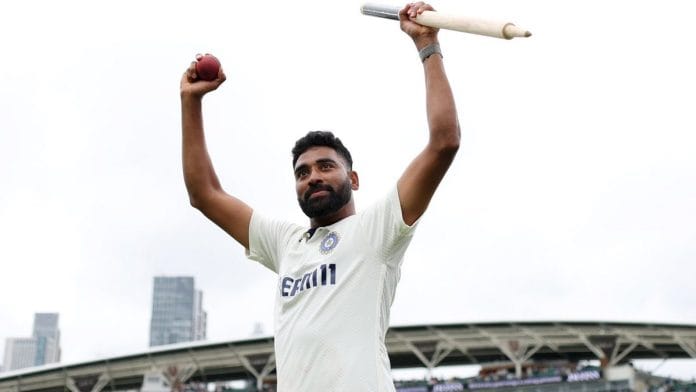Mohammed Siraj’s performance in the India-England Test series, particularly during the final match at The Oval, has drawn admiration from nearly every corner. But you know you’ve arrived when the praise comes from Sachin Tendulkar himself.
“Unbelievable. Superb approach. I like that attitude. Love the spring in his legs,” Tendulkar said. “No batsman likes a fast bowler who is in your face relentlessly… the speeds he bowled in his last few deliveries like 90mph it shows jigar—he has a big heart.”
Having taken 23 wickets across the series, Siraj was at the heart of India’s narrow 6-run win in the final Test, levelling the series 2–2 and earning rare and unanimous accolades for his performance.
Mohammed Siraj is an exceptional Indian cricketer, and that, in principle, should be the beginning and end of the story. But in today’s India, visibility rarely travels alone. As a Pasmanda Muslim, Siraj is also being pulled into symbolic service.
Also Read: Saudi Arabia is changing. It can shape the future of Muslim world
Pasmanda pride
Known for his climb from modest beginnings, 31-year-old Siraj has become one of the most reliable fast bowlers in Indian cricket — across formats, conditions, and pressure. He’s been the man of the hour many times for his cricketing achievements, but he’s also become a de facto mascot for Pasmanda Muslims.
AIMIM leader Asaduddin Owaisi tweeted praise, calling him “Pasha,” a term loaded with cultural and caste significance.
Always a winner @mdsirajofficial! As we say in Hyderabadi, poora khol diye Pasha! pic.twitter.com/BJFqkBzIl7
— Asaduddin Owaisi (@asadowaisi) August 4, 2025
For many Pasmanda Muslims, Siraj’s rise represents a quiet challenge to a national imagination that prefers its heroes without context.
On X, one commenter celebrated Siraj’s ascent to the top of the ICC ODI bowling rankings by invoking his sub-community: “He belongs to Mansoori/Dhuniya (cotton carders) from Pasmanda Muslim Community. Jai Pasmanda!” On Owaisi’s post, one commenter wrote tongue in cheek: “Pasha ne puncture bana diya” — a play on the stereotype of Muslims being stuck in jobs like tyre repair.
The sentiment was less about cricket and more about the subtle radicalism of a name like Siraj being spoken with national pride. On social media, his success is read as proof that someone from a working-class, Pasmanda background can stand at the centre of Indian pride.
As a Pasmanda Muslim, it genuinely makes me happy to see others from the community finding in Mohammed Siraj a positive role model — someone who gives them a reason to believe that they, too, can belong to the national mainstream.
The Pasmanda community has lived with generations of marginalisation, often left behind even within Muslim society. I know that not everyone will be as fortunate as Siraj, and the system is far from easy. But just having hope — the belief that your identity alone won’t automatically block your path — is a powerful message. Mohammed Siraj, simply by being where he is, sends that message. And for a community that has been told in so many ways that it doesn’t count, that matters more than most people realise.
A space for belonging
Ideally, Mohammed Siraj’s religious identity shouldn’t matter. But we don’t live in ideal world yet.
Cricket, often called India’s unofficial religion, has long been a space where belief systems blur and national pride takes over. Whether a player prays to Ram, Allah, Guru Nanak or Jesus, their talent has been celebrated across divides. By and large, that still holds true. Siraj is a hero to many, across backgrounds.
But in the age of social media, the margins have microphones. Voices once too fringe to be taken seriously now find reach — and Siraj has not been spared. He has faced backlash simply for thanking Allah after a win, or for sharing a photograph from his Umrah pilgrimage.
Even so, his success is a reminder of the quieter majority. The India that still values what a player does on the field more than who they pray to off it. In that sense, Siraj also represents another possibility: that identity need not be a barrier, and that there is still space, however fragile, for belonging.
Also Read: Are Indian Muslims privileged or victims? Rijiju, Owaisi aren’t giving you the full picture
Heroes vs larger realities
One important thing I’ve come to believe, especially in Siraj’s case, is that when talented people are given the chance, they can achieve extraordinary things, regardless of their identity or background. I’ve always advocated for seeing such stories as models within the community. They send a powerful message: that we can build ourselves, contribute meaningfully, and be a positive force in the nation.
But over time, I’ve also come to understand that one person’s success, even when it is as remarkable as Siraj’s, doesn’t easily translate into mass upliftment. These stories show us what’s possible, but possibility alone doesn’t create change.
To truly transform a community that has been marginalised for generations, we need more: a shift in mindset, equitable access to resources, thoughtful policies, and sustained social programmes. Only then can we move beyond celebrating a few heroes and begin to count real change.
It’s good to have heroes — but it’s even better to see change in everyday life.
Amana Begam Ansari is a columnist, writer, and TV news panellist. She runs a weekly YouTube show called ‘India This Week by Amana and Khalid’. She tweets @Amana_Ansari. Views are personal.
(Edited by Asavari Singh)







Someone from Print once said that there we should not associate cast or religion with the people. I am very happy to see them do it. Print is changing. Can you please make an article on “Aryan Sharma and Yash Deshmukh” as well, there heroes to some communities.